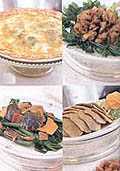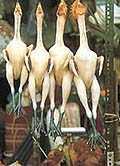|
|
|
 |
Food |
| Chinese
Cuisine |
 |
Chiu
Chow
Chiu Chow
cuisine, also known as Swatow food, originated from the city of Swatow
in the coastal region of Guangdong. Seafood, goose, and duck are eminent
features of this cuisine. The Chiu Chow people have a unique method of
harvesting oysters by pushing bamboo sticks into oyster beds. They then
wait for the sticks to encrust with mollusks. After that, the oysters
are made edible and tasty just by grilling the oysters in their shells
over a fire. In restaurants, however, oysters are fried in egg batter
and clams served in a spicy sauce of black beans and chilies. Gray mullet
is a popular cold dish, and pomfret fish smoked over tea leaves, along
with fresh-water eel stewed in brown sauce are other highly recommended
dishes.
 Sauces
are often sweet, using tangerine or sweet beans for flavor. Chiu Chow
chefs are particularly skilled in carving raw vegetables into floral designs,
thus bringing forth Hong Kong's most artistic dishes. Two of the most
expensive Chinese delicacies - shark's fin and bird's nest - are the pride
of Chiu Chow cuisine. The dried saliva, which lines the edible swiftlet's
nest, provides the magic base for the famous birds nest soup. This nourishing
saliva is said to rejuvenate the old and can be eaten together with coconut
milk or almonds. The finest birds nest is claimed by a Hong Kong restaurateur
who rents a mountain in Thailand, which he believes harbors the finest
set of swiftlet nests in Southeast Asia. Sauces
are often sweet, using tangerine or sweet beans for flavor. Chiu Chow
chefs are particularly skilled in carving raw vegetables into floral designs,
thus bringing forth Hong Kong's most artistic dishes. Two of the most
expensive Chinese delicacies - shark's fin and bird's nest - are the pride
of Chiu Chow cuisine. The dried saliva, which lines the edible swiftlet's
nest, provides the magic base for the famous birds nest soup. This nourishing
saliva is said to rejuvenate the old and can be eaten together with coconut
milk or almonds. The finest birds nest is claimed by a Hong Kong restaurateur
who rents a mountain in Thailand, which he believes harbors the finest
set of swiftlet nests in Southeast Asia.
Other equally
tasty Chiu Chow specialties are the baked rice birds, which are seasonal
fowl dishes stuffed with chicken liver and served by the dozens, as well
as minced pigeon cooked with water chestnuts and eaten wrapped in crispy
lettuce leaves spiked with a smack of plum sauce. A Chiu Chow meal ends
with desserts made from taro, water chestnuts, and sugar-syrup, which
are then washed down with cups of strong 'kungfu' tea. A simply extraordinary
meal!
Hakka
 Hakka
settlers mainly dwell in Hong Kong's New Territories. When they migrated
from the northern regions of China to Hong Kong, they brought along their
own traditional cooking. Their main dishes are stuffed duck and salt-baked
chicken. Preparation of the stuffed duck requires some amount of time.
The bird has to be deboned through a hole in the neck and then stuffed
with a rich assortment of glutinous rice, chopped meats, and lotus seeds.
Hakka cooking also makes do with unusual food sources, such as braised
chicken's blood or pig's brain stewed in Chinese wine. These may seem
repulsive to most foreigners, but to the Chinese, they make tasty delicacies
that are good for one's health. Hakka
settlers mainly dwell in Hong Kong's New Territories. When they migrated
from the northern regions of China to Hong Kong, they brought along their
own traditional cooking. Their main dishes are stuffed duck and salt-baked
chicken. Preparation of the stuffed duck requires some amount of time.
The bird has to be deboned through a hole in the neck and then stuffed
with a rich assortment of glutinous rice, chopped meats, and lotus seeds.
Hakka cooking also makes do with unusual food sources, such as braised
chicken's blood or pig's brain stewed in Chinese wine. These may seem
repulsive to most foreigners, but to the Chinese, they make tasty delicacies
that are good for one's health.
Peking
 Originating
from the imperial courts of northern China, Peking food is extremely rich
and strongly spiced with coriander, peppers, and garlic. Noodles, dumplings,
and breads are the features of this region's cuisine. The most popular
world-wide dish is the Peking Duck. The duck's crispy skin is wrapped
in thin pancakes with spring onions, cucumber, and plum sauce, and is
well liked by both Chinese and foreigners alike. In some restaurants,
diners will be regaled by the waiter who demonstrates how the skin is
cut to perfectly lean slices and enveloped in smooth, white-colored pancakes,
along with other ingredients. The leftover duck meat is then brought into
the kitchen to be stir-fried or cooked to the diners' liking. Originating
from the imperial courts of northern China, Peking food is extremely rich
and strongly spiced with coriander, peppers, and garlic. Noodles, dumplings,
and breads are the features of this region's cuisine. The most popular
world-wide dish is the Peking Duck. The duck's crispy skin is wrapped
in thin pancakes with spring onions, cucumber, and plum sauce, and is
well liked by both Chinese and foreigners alike. In some restaurants,
diners will be regaled by the waiter who demonstrates how the skin is
cut to perfectly lean slices and enveloped in smooth, white-colored pancakes,
along with other ingredients. The leftover duck meat is then brought into
the kitchen to be stir-fried or cooked to the diners' liking.
Another popular
dish is the Beggar's chicken, which is stuffed with vegetables and herbs
and sealed with clay before being cooked slowly. The guest of honor is
usually invited to break open the chicken with a mallet.
If one is
lucky enough, chefs at Peking restaurants display a 'noodle show' where
they exhibit their expertise in tossing lumps of dough into the air until
it turns into strands of noodles to be cooked.
Shanghainese
 Shanghai
cuisine is typically heavier and oilier than other Chinese food. The foods
are seasoned with sugar, soy sauce, and Shaoxing wine, thus producing
a sweet and zesty combination. Dishes are served in big portions and in
thick sauces. Steamed dumplings and hairy crabs are features of this cuisine. Shanghai
cuisine is typically heavier and oilier than other Chinese food. The foods
are seasoned with sugar, soy sauce, and Shaoxing wine, thus producing
a sweet and zesty combination. Dishes are served in big portions and in
thick sauces. Steamed dumplings and hairy crabs are features of this cuisine.
Hairy crabs
are mostly eaten in late autumn when these freshwater crabs are sent from
mainland China. This is a rather sought after steamed dish in Hong Kong.
The best months to try hairy crabs are in September and October. Other
year-round Shanghainese favorites include hot-and sour-soup, drunken chicken,
yellow fish, and braised eel.
Szechuan
 Bursting
with flavor, Szechuan food is one of the spiciest cuisine in China. Some
restaurants in Hong Kong often combine Peking and Szechuan dishes together
so that people can taste the differences between the two. Szechuan chefs
often add rich spices into their dishes. The spices include star anise,
fennel seed, chili, coriander, and garlic. Common methods of cooking are
smoking and shimmering that will give the fragrant seasonings time to
infuse the food with mouth-watering tastes and aromas. It is not necessary
for all the dishes of this cuisine to be hot and spicy. The crispy beef
deep-fried with tangy kumquat peel, and smoked duck in camphor wood and
tea leaves are favorites on the table. Unlike the northern preference
for rice, Szechuan cuisine features a variety of noodles and steamed bread. Bursting
with flavor, Szechuan food is one of the spiciest cuisine in China. Some
restaurants in Hong Kong often combine Peking and Szechuan dishes together
so that people can taste the differences between the two. Szechuan chefs
often add rich spices into their dishes. The spices include star anise,
fennel seed, chili, coriander, and garlic. Common methods of cooking are
smoking and shimmering that will give the fragrant seasonings time to
infuse the food with mouth-watering tastes and aromas. It is not necessary
for all the dishes of this cuisine to be hot and spicy. The crispy beef
deep-fried with tangy kumquat peel, and smoked duck in camphor wood and
tea leaves are favorites on the table. Unlike the northern preference
for rice, Szechuan cuisine features a variety of noodles and steamed bread.
Top
of Page
|
